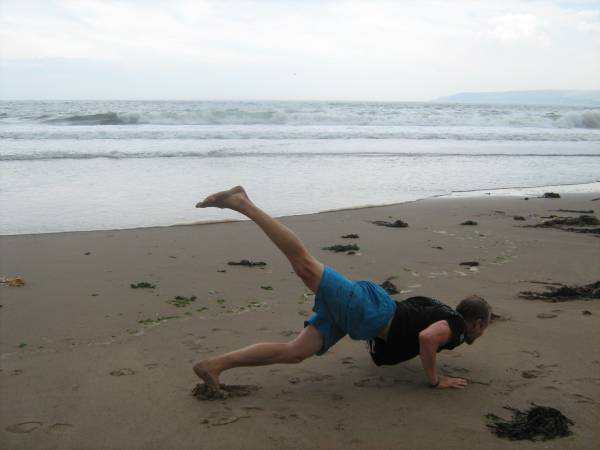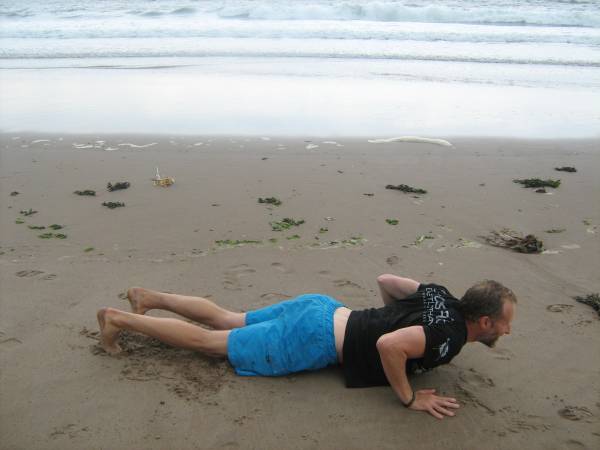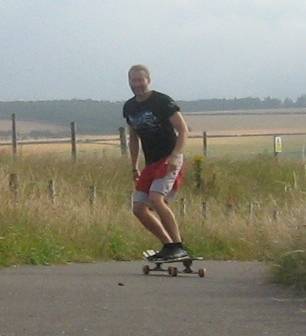Surfers from parts of the world that get consistent surf stay surf fit by practicing what they love in a constantly changing environment that ensures they are always ready for the uncertainties a surf session will throw at them. For the rest of the world, who either live on inconsistent coastlines or have to fit surfing in around work and other commitments, staying surf fit can be a bit of a dilemma.
Even with necessary proprioceptive skills, an experienced surfer can struggle to get any waves if his paddling endurance and power are not up to scratch. A plethora of videos and information on the Internet and in books show surfers using Swiss balls and pulley systems to get surf fit. There’s even a video of the great Laird Hamilton standing on a balance board doing wood chops with a cable pulley. I would like to lay down a solid argument that this approach is incorrect and a CrossFit approach is the correct way for surfers who can’t get to the ocean every day to prepare for their hobby.
This article is directed at those who can surf but do not have access to the surf every day. Without the ability and knowledge of how to paddle a surfboard, sit on it, line up a wave, and transition from prone to standing, no amount of any dry-land training can prepare for this nor can any other physical skill compensate for it.
For those who can surf, no amount of standing on a Swiss ball doing pulley rowing will improve any aspect of their surfing. The ability to actually stand and surf is somewhat like riding a bike. During periods away from the water, this is not the part of the surfing experience that is lost. What suffers is the ability to paddle and duck dive through lines of white water, then turn and powerfully paddle (whilst already fatigued), then dynamically transition from prone to standing.
Let me explain in more detail. The hyperextended position whilst paddling a surfboard places great emphasis on the posterior chain, particularly the erector spinae, anterior deltoid, and triceps. Small muscular fatigue sets in long before any aerobic state can be reached. The comes duck diving. Duck diving involves pushing the board deep enough under on coming white water and creating a streamlined position for the board and body to pass under the dissipating power of the wave. This movement is frequently repeated in a hypoxic state and also requires grip strength if performed incorrectly. After that, catching a wave requires dynamic power strokes and a quick jump from prone to standing. And then turning a surfboard when standing requires transition of power from heel to toe or vice-versa whilst creating drive from the hips.
You can possibly already see where I am going with this.
CrossFit mimics a lot of this and practices the others.
 CrossFit also takes in to account the preparation for the unknown that the ocean offers. One day of surfing may involve one long ride after another where your arms and legs feel like lead from the constant paddling and turns. Another day may involve constant frantic duck diving trying to avoid being washed onto a dry reef. CrossFit more than adequately trains for this type of mental resolve whilst trying to complete a single action whilst gasping for oxygen (think “Karen” or seven minutes of burpees). Power in surfing is often needed whilst already in a fatigued state, something criticized about CrossFit programming but so necessary in real life and many sports.
CrossFit also takes in to account the preparation for the unknown that the ocean offers. One day of surfing may involve one long ride after another where your arms and legs feel like lead from the constant paddling and turns. Another day may involve constant frantic duck diving trying to avoid being washed onto a dry reef. CrossFit more than adequately trains for this type of mental resolve whilst trying to complete a single action whilst gasping for oxygen (think “Karen” or seven minutes of burpees). Power in surfing is often needed whilst already in a fatigued state, something criticized about CrossFit programming but so necessary in real life and many sports.
I personally believe that the demands of surfing can be met by using CrossFit standards. Games-style burpees perfectly mimic the power, stamina, mobility, and muscular endurance required in the surf zone, but they can also be tweaked to be more akin to the actual pop-up position, as seen in the photos. Dive-bombers can also be used in a workout. These can be performed on one to mimic perfectly the streamlined movement required whilst duck diving under a wave.
 So where do pulley rows fit into dry-land training for surfing? The answer is, they don’t. Whilst in the paddling position on a surfboard, the arms pull the body forward. With a typical pulley system the hands are being pulled towards the body. A better option for increasing paddling power is pull ups and, better still, muscle ups – as paddling involves both a pull and then a push. To closer mimic the state of fatigue often involved in paddling out through the impact zone these exercises need to be done whilst in oxygen debt, a couplet of pull ups and either burpees or wall ball comes immediately to mind.
So where do pulley rows fit into dry-land training for surfing? The answer is, they don’t. Whilst in the paddling position on a surfboard, the arms pull the body forward. With a typical pulley system the hands are being pulled towards the body. A better option for increasing paddling power is pull ups and, better still, muscle ups – as paddling involves both a pull and then a push. To closer mimic the state of fatigue often involved in paddling out through the impact zone these exercises need to be done whilst in oxygen debt, a couplet of pull ups and either burpees or wall ball comes immediately to mind.
Using the beach environment to do a workout is often neglected by city-based surfers. Actually getting into the sea when it is flat and training there can be a great environmental practice. On surfless summer days (very frequent around here), I’ll get my workout on down at the beach. A favorite of mine is to run to the far end of the beach, wade out to neck deep, swim sprint in, do 10 burpees, run 100m or so to the rocks, grab a large boulder and throw it down to the water line, then wade back out and repeat. After the workout, I’ll swim back. Head up crawl is better practice for paddling or swimming in the surf zone, and just letting the legs drag taxes the shoulders even more. Workouts can also be done in the swimming pool, it doesn’t quite recreate the open water environment but length sprints combined with push ups and squats at either end make a simple but effective workout.
 Turns on a surfboard require the type of hip powered heel toe, toe heel drive that comes from Olympic lifts. This change of pressure across the feet can also be recreated on dry land with a longboard skate as any surfer knows. How about a longboard skate workout? Skate downhill practiscing linked turns, stop, do 20 over the board burpees, then run or push back uphill and repeat.
Turns on a surfboard require the type of hip powered heel toe, toe heel drive that comes from Olympic lifts. This change of pressure across the feet can also be recreated on dry land with a longboard skate as any surfer knows. How about a longboard skate workout? Skate downhill practiscing linked turns, stop, do 20 over the board burpees, then run or push back uphill and repeat.
In conclusion, the only real way to improve your surfing is to surf and get in the water as much as possible. But for those who have the necessary skills, conditioning becomes the critical factor. If your goal is to get the beach when you can and actually catch your share of waves and not be left sitting on your board watching, then CrossFit programming (with or without a few sport specific tweaks) will fulfill your needs.






